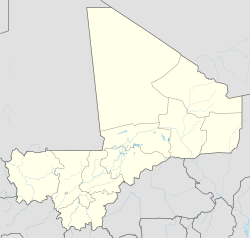Kayes, Mali
|
Kayes Kayi, Xaayi |
|
|---|---|
| Commune and city | |

Men cross a busy street in Kayes, 2006.
|
|
| Location within Mali | |
| Coordinates: 14°27′N 11°26′W / 14.450°N 11.433°WCoordinates: 14°27′N 11°26′W / 14.450°N 11.433°W | |
| Country |
|
| Region | Kayes |
| Cercle | Kayes Cercle |
| Town founded | 1880s |
| Elevation | 33 m (108 ft) |
| Population (2009 census) | |
| • Total | 127,368 |
| Time zone | GMT (UTC+0) |
Kayes (Bambara: Kayi, Soninké: Xaayi) is a city in western Mali on the Sénégal River, with a population of 127,368 at the 2009 census. Kayes is the capital of the administrative region of the same name. The name "Kayes" comes from the Soninké word "karré", which describes a low humid place that floods in rainy season. The city is located 420 kilometres (260 mi) northwest of the capital Bamako.
Prior to French colonial expansion, Kayes was a small village. Its location on the path of the future Dakar-Niger Railway, and the French need for trade centers, led to the creation of the Kayes market town in 1881. It remains a transport hub, primarily for Senegalese trade, to this day. In 1892, Kayes became the capital of the French Sudan; Bamako replaced it as the capital, first of the state of Haut Sénégal-Niger on October 17, 1899, then as the capital of all of French Sudan in 1908.
Kayes lies on the Route Nationale 1 (RN1) highway and is 612 km (380 mi) by road from Bamako and 96 km (60 mi) from the border with Senegal. The town has an international airport (Kayes Airport), and lies on the Dakar-Niger Railway which offered regional passenger train service to Bamako three times a week via Kati and Diamou as of 2013. The area is rich in gold and iron.
The climate is subject to the West African Monsoon with all the rainfall occurring between June and October. August is the wettest month. There is almost no rainfall during the other seven months of the year. The total annual rainfall is around 650 mm. Kayes is nicknamed the "pressure cooker of Africa" due to its extreme heat; the town is surrounded by iron-rich mountains which contribute to the temperature. The town has been described as the hottest continuously inhabited town in Africa. The average daily high temperature in the city is 37 °C (99 °F), with temperatures usually peaking in April at an average of nearly 44 °C (111 °F).
...
Wikipedia

